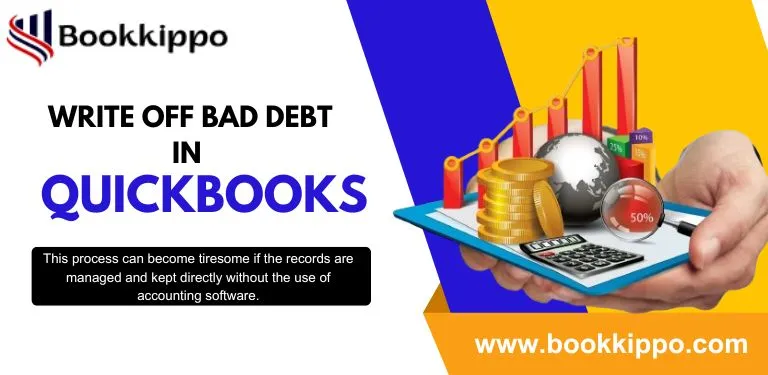
How to Write Off Bad Debt in QuickBooks Desktop & Online?
For making necessary decisions and promoting growth, it is crucial to unlock the true potential of your business data. In the digital period, business software or tools like QuickBooks Desktop & Online provide accuracy and help in managing your finances, inventory, etc. In this blog, we will discuss how to write off bad debt in QuickBooks Desktop and Online.
People using this software can also download its mobile app version known as QuickBooks Online Accounting from the App Store and Play Store. The mobile version is a great option for sending invoices, and reminders and getting paid in real time. However, QuickBooks Desktop is only available for users using the Microsoft Windows operating system. The accounting software supports Windows 10 and later, and has ended the support for Windows 7.
Table of Contents
ToggleWhat Does it Mean to Write Off Bad Debts in Quickbooks?
Bad debt occurs when an amount that was in a profitable form and was meant to be received from a client fails to be recovered in any organization. In easy words, bad debts mean that a customer pays money and you are unable to collect it.
For Intuit or QuickBooks users, It is easier for a business owner or a small organization to observe profitability and average net turnaround when bad debts are written off. However, the process can become tiresome if the records are managed and kept directly without the use of accounting or bookkeeping software.
Importance Points to Note
These points are essential in the process of writing off bad debt in Quickbooks Desktop. You have to follow these points before going to the next part:
- It also allows you to write off bad debts as deductions.
- With this function, you can get acquainted while creating a bad debt account with various types of bad debts and overdue invoices.
- You can write off overpayments with the help of QuickBooks Software.
Common Reasons for Bad Debts in QuickBooks
Whether it is a bank, money-related institution, provider, or merchant, anybody can have bad debts on their books. A bad obligation generally happens when the indebted person denies or cannot pay debts due to insolvency, carelessness, or money-related trouble.
What are the steps to Write Off Bad Debt in QuickBooks Desktop?
It is crucial to record several types of invoices and write off bad debt in Quickbooks Desktop. This feature ensures that your accounts have the latest transactions updated. Here is the step-by-step guide for writing off bad debt in Quickbooks Desktop:
Step 1: Add an expense account to track the bad debt
- Go to the List menu and select the Chart of Accounts option.
- Select the Account menu and then click on New.
- Select Expense, and then Continue.
- Enter an Account Name, such as Bad Debt.
- Select Save and Close.
Step 2: Close out the unpaid invoices
- Go to the Customers menu and then select the Receive Payments option.
- Enter the name of the appropriate customer in the Received from section.
- For the Payment amount, enter $0.00.
- Select Discounts and credits.
- Enter the amount that you would like to write off from the amount of discount section.
- For Discount Account, select the account you added in step 1, and then click on Done.
- Then select Save and Close.
Steps to Write Off Bad Debt in QuickBooks Online
Follow the steps given below to write off bad debt in Quickbooks Online:
Step 1: Review aging accounts receivable
- Firstly, you have to go reports menu.
- After that, find for and open accounts receivable aging details reports.
- Now, check which of the accounts receivable outstanding can be written off.
Step 2: Create a bad debts expense account
- First, go to the settings option and select the charts of accounts.
- Now, create a new account by clicking on the New tab.
- Select the expense option from the dropdown window.
- After choosing expense, select bad debts from the details dropdown option.
- Lastly, click on the save and close options.
Step 3: Create a bad debt item
- As previous one move to the settings tab and now, click on the products and services.
- After that, you have to click on the new tab and choose non-inventory.
- Select the bad debts option from the account dropdown option.
- After completing the process select save and close tabs.
Step 4: Create a credit note for bad debt
- Select the credit note after choosing the New option.
- Choose a customer from the customer dropdown and select bad debts in the products and services section.
- You have to enter an amount in the amount section and enter the bad debts.
- Now, click on the save and close option.
Step 5: Applying the credit note to the invoice
- First, choose the New option and select Receive Payment from the customer dropdown option.
- Choose an appropriate customer.
- Move to QuickBooks invoices from the transaction section.
- Now, click on the credit note from the credit option.
- Lastly, click the save and close option.
Step 6: Run a bad debt report
- Move to the setting option and head to the charts of accounts.
- Click on the run report from the action section.
- Go to the sales menu and choose the appropriate customers.
- Select the customer’s name and click on the edit tab.
- After the customer’s name go to the display field and enter the bad debt or no credit option.
- Finish the process by clicking on the save button.
Conclusion
Hopefully, it may have become easier for you, to now understand how to write Off bad debt in QuickBooks Desktop & Online. To keep track of which debtors are about to default, an Account Receivable Aging Detail Report should run regularly.
Read More Articles:





